
Ever wondered what lies at the heart of yoga beyond the physical postures? The Yoga Sutras of Patanjali a 2,500-year-old Sanskrit text offers the answer. Often called the “bible of yoga,” this foundational scripture contains 196 short sutras (aphorisms) that outline a complete path to mental clarity, spiritual growth, and self-realisation.
While modern yoga often focuses on asanas (poses) and pranayama (breathwork), Patanjali’s core teaching reveals yoga’s true purpose: mastery of the mind. From overcoming inner obstacles (kleshas) to attaining ultimate freedom (kaivalya), the Yoga Sutras serve as a timeless guide for anyone seeking peace and purpose.
In today’s fast-paced world, Patanjali’s wisdom is more relevant than ever. Whether you’re a beginner or a lifelong practitioner, exploring the Yoga Sutras can help you:
- Deepen your yoga practice – Move beyond the physical to understand yoga’s true essence.
- Manage modern stress – Apply ancient tools to reduce anxiety, sharpen focus, and restore balance.
- Understand key yogic terms – Learn the meaning behind Sanskrit concepts like Chitta, Samadhi, and Ashtanga Yoga.
Who is sage patanjali?
Sage Patanjali is one of the most revered figures in Indian spiritual and philosophical traditions, best known for composing the Yoga Sutras a foundational text that defines the path of Raja Yoga and the discipline of the mind.
While exact details of his life remain uncertain, Patanjali is believed to have lived between the 2nd and 4th centuries CE. His legacy spans multiple disciplines, and he is often regarded as a spiritual polymath. Across India, some traditions also honour him as a semi-divine figure, associating him with Sheshanaga, the cosmic serpent in Hindu mythology.
Patanjali is credited with three major contributions:
- Yoga Sutras – A systematic presentation of Raja Yoga, emphasizing mental discipline and self-realization.
- Ayurveda – A treatise on health and well-being, believed to guide the purification of the body.
- Mahabhashya – A comprehensive commentary on Sanskrit grammar, refining Panini’s linguistic work.
Each of these works reflects his deeper mission: to purify speech (grammar), body (Ayurveda), and mind (Yoga) the three key dimensions of human experience.
Whether seen as a historical scholar or a mythical seer, Patanjali’s influence remains timeless, shaping the practice and understanding of yoga around the world.
History of sage patanjali
The exact history of Sage Patanjali remains a mystery. There is no definitive record of his birth or life events, but most scholars estimate that he lived between the 2nd and 4th century CE. Some traditional sources claim he lived around 2500 years ago, though this is more symbolic than historically verified.
What we do know is that Patanjali’s Yoga Sutras mark a turning point in the evolution of yoga. While yoga as a spiritual and meditative practice predates him by thousands of years, rooted in the Vedic tradition over 5,000 years ago, Patanjali did not invent yoga he organised and systematised it.
His Yoga Sutras, composed of 196 concise aphorisms, distilled the vast and diverse yogic teachings of earlier eras into a clear, structured path now known as Raja Yoga. This makes his work a codification of pre-existing yogic knowledge, not a standalone creation.
Patanjali’s contribution helped transform yoga from a loosely transmitted oral tradition into a formal system of inner discipline, mental mastery, and spiritual liberation.
The mythological story of patanjali’s birth
Hindu Puranas, ancient scriptures that narrate mythological stories, also mention the birth of Sage Patanjali. These legends, passed down through generations, provide a mystical perspective on his existence. While these stories are not historically verified, they highlight the reverence and divine status attributed to Patanjali.
According to Hindu mythology, Patanjali is believed to be an incarnation of Sheshanaga, the divine serpent on which Lord Vishnu reclines.
1. Lord shiva’s cosmic dance & sheshanaga’s desire
According to legends;
- Once, Lord Shiva, in his form as Nataraja (Lord of Dance), performed his divine dance (Tandava).
- The intensity of Shiva’s dance caused Lord Vishnu’s body to vibrate, making him unusually heavy. This discomforted Sheshanaga, as he struggled to bear the weight of his master.
- After Shiva’s dance ended, Vishnu’s weight returned to normal. Curious about this phenomenon, Sheshanaga asked Vishnu about its cause.
- Vishnu explained that the vibrations came from the divine energy of Shiva’s dance. Fascinated, Sheshanaga expressed a deep desire to learn this celestial dance.
Impressed by Sheshanaga’s devotion, Vishnu prophesied that he would be blessed by Lord Shiva and take human form to learn and spread this knowledge on Earth.
2. Sheshanaga’s incarnation as patanjali
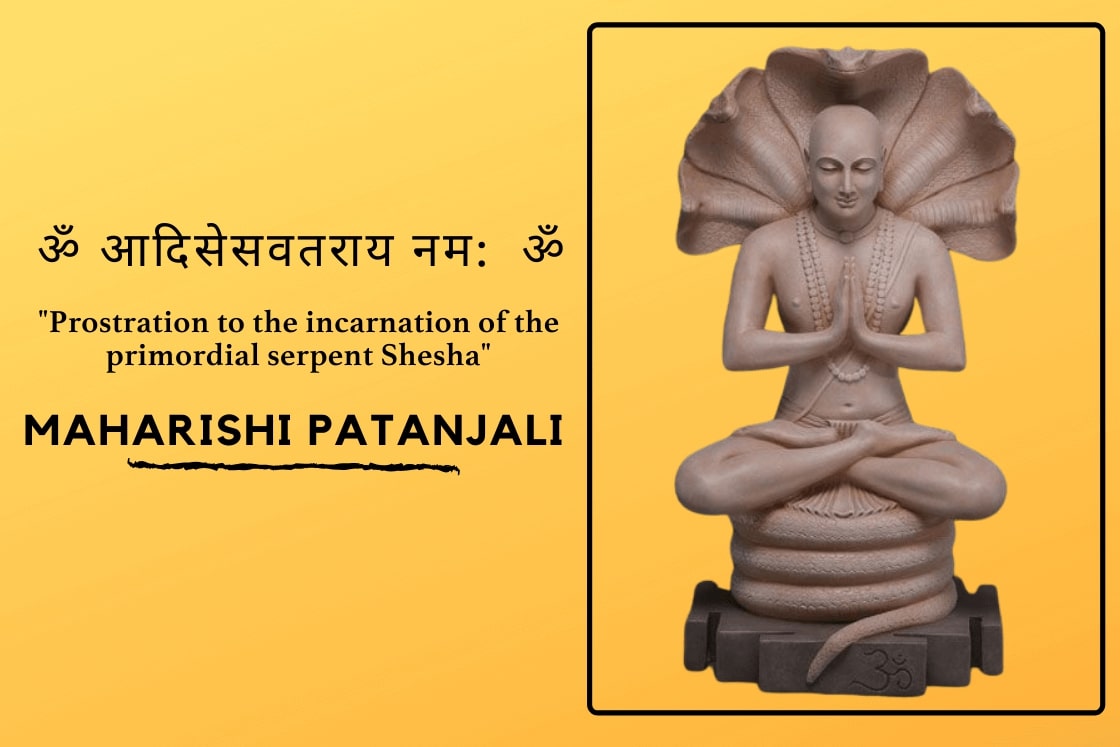
Following this divine decree, Sheshanaga was born as Patanjali to a devoted yogini named Gonika.
- Gonika, a spiritually enlightened woman, prayed to the Sun God, seeking a son to whom she could pass on her yogic knowledge.
- As a divine response, she took a handful of water in her palms and offered it to the Sun in prayer.
- At that moment, a tiny serpent descended from the sky into her hands and immediately transformed into a human child.
- With folded hands (Anjali Mudra), the child requested her to accept him as her son.
- Seeing this as a divine blessing, Gonika named him “Patanjali”, where:
- “Pata” means “to fall from above”
- “Anjali” refers to a hand gesture of prayer
Thus, Patanjali’s birth was seen as a celestial event, fulfilling a divine mission to spread yoga.
The story of patanjali’s teachings & the yoga sutras
Patanjali is credited with compiling the Yoga Sutras, a text that forms the foundation of Raja Yoga. However, mythology offers an interesting story about how his teachings came into existence.
1. The 1000 Disciples & the Veil of Mystery
- Patanjali gathered 1000 disciples to teach them the profound knowledge of yoga.
- He imposed a strict rule: the students must focus only on his teachings and must not attempt to see him.
- He sat behind a curtain, instructing them through voice alone.
However, curiosity got the better of them.
- One disciple secretly peeked behind the curtain, disobeying the rule.
- The moment this happened, 999 students were instantly burned to ashes due to the breach of discipline.
2. The Cursed Disciple & Patanjali’s Compassion
- One student had left the hall momentarily and returned to find all others reduced to ashes.
- Patanjali, deeply saddened, cursed the souls of the burned students, condemning them to exist as Brahmarakshasas (wandering spirits).
- These spirits were told that they could only be liberated if they successfully taught yogic wisdom to a worthy student.
3. Patanjali’s act of redemption
For years, these spirits could not find a student willing to learn yoga from them. Out of compassion, Patanjali himself chose to become their student, learning back the same knowledge he had once imparted.
- As he learned, he carefully documented all yogic knowledge in concise, systematic aphorisms these became the Yoga Sutras.
- The Yoga Sutras of Patanjali thus became a refined codification of ancient yoga teachings.
The symbolism behind patanjali’s story
While these stories are mythological, they hold deeper symbolic meanings:
- Patanjali teaching behind a curtain may signify that true knowledge is beyond external appearances the teacher’s identity is irrelevant; only the wisdom matters.
- The disciples turning into ashes could represent how breaking discipline and impatience in spiritual practice can lead to destruction.
- The idea of relearning from a disciple suggests that knowledge should be continually refined and passed down responsibly.
Invocation to sage patanjali
A traditional invocation chant is recited in honor of Patanjali before yoga practice. This Sanskrit verse acknowledges his contributions to yoga, health, and grammar:
Yogena cittasya padena vacam, Malam sarirasya cha vaidyakena.
Yopakarottam pravaram muninam, Patanjalim pranjaliranato’smi..
Translation:
“I bow to the sage Patanjali, who purified the mind through yoga, speech through grammar, and body through Ayurveda.”
This chant serves as a reminder of Patanjali’s multidimensional wisdom and is often recited at the beginning of yoga sessions.
Yoga sutras of patanjali (YSP) – The text
In Hinduism, the yogic system is one of the six classical philosophies (Shad-Darshanas) that guide a seeker toward moksha (liberation) by exploring the nature of the mind and consciousness.
Each philosophical system has an authoritative text and a Sutrakara (sage who codified the teachings). The Yoga Sutras of Patanjali (Pātañjalayogaśāstra) is the foundational text of Yoga Darshan (the philosophy of yoga). It consists of 196 sutras (concise aphorisms) that systematically outline the path to spiritual liberation. Each sutra acts as a thread, connecting various aspects of life to higher consciousness, ultimately leading to moksha.
What does ‘Sutra’ mean in the yoga sutras?

The term Sutra is widely used in spiritual traditions to represent the condensed teachings of great masters. In Sanskrit, Sutra literally means “thread” and is often translated as “aphorism”—a brief, yet profound statement that conveys essential wisdom without elaborate explanation.
According to YourDictionary, an aphorism is:
“A brief saying or phrase that expresses an opinion or imparts wisdom without the flowery language of a proverb.”
A useful analogy compares a Sutra to a mathematical formula short, definitive, and precise, yet holding deep meaning that can be expanded upon through study and contemplation.
Sadhguru’s interpretation of sutra as a thread
Spiritual teacher Sadhguru explains Sutra using the metaphor of a thread in a garland. The thread holds the garland together, just as the Sutras form the foundation of yogic knowledge. However, the beauty of a garland comes from the flowers, beads, or jewels strung upon it similarly, the true essence of the Yoga Sutras emerges when their wisdom is applied in daily life. Without practice and experience, the Sutras remain mere words, like a garland with only a thread and no adornment.
Thus, the Yoga Sutras provide the essential framework for spiritual growth, but their true power lies in how one integrates them into personal practice.
The 4 chapters of the yoga sutras of patanjali
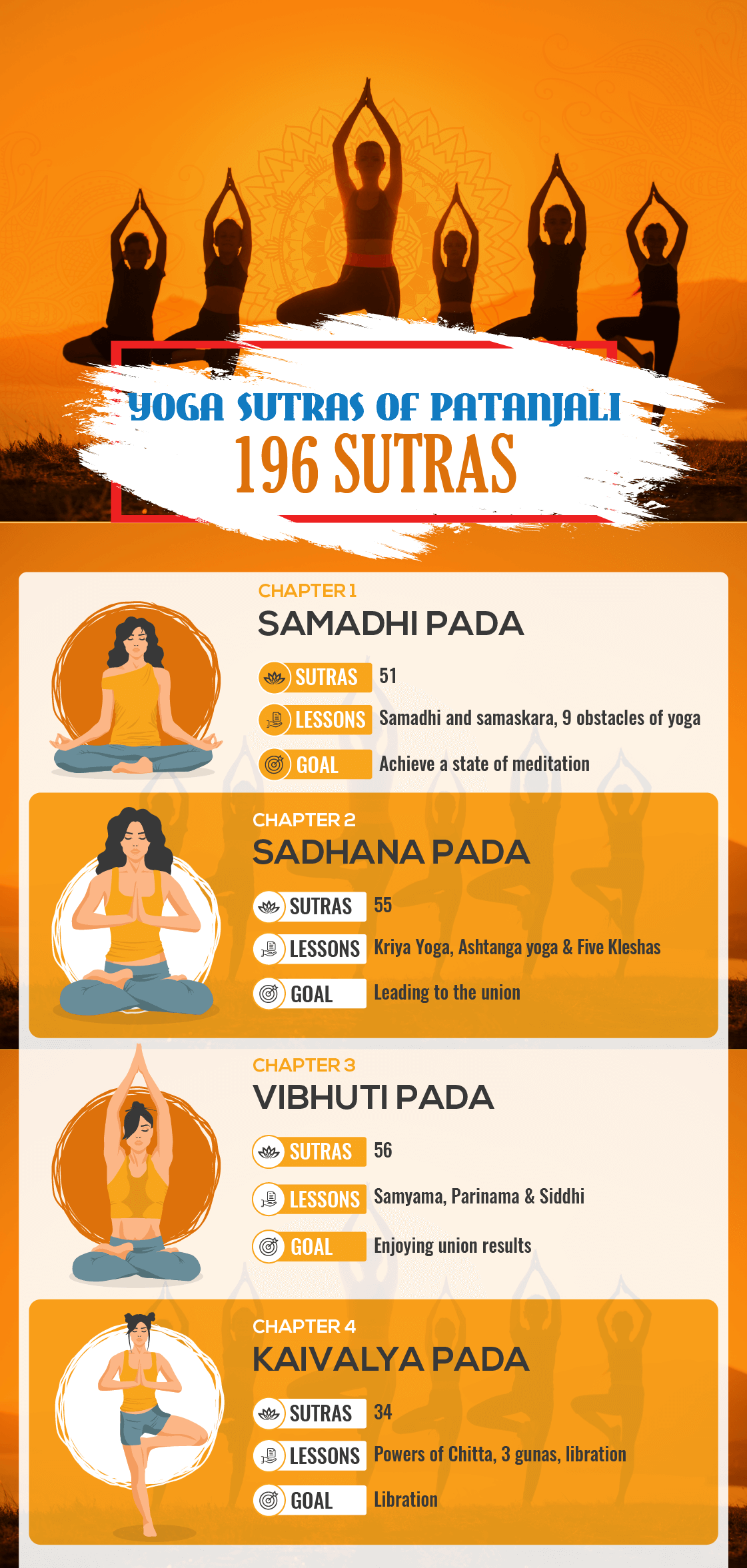
The Yoga Sutras of Patanjali are divided into four chapters, known as Padas. Each chapter builds upon the previous one, offering a structured and progressive guide to the path of yoga from the fundamentals of concentration to the ultimate goal of liberation (Kaivalya). These chapters combine philosophy, practical techniques, obstacles, and spiritual wisdom for the yogic journey.
- Samadhi Pada – The Chapter on Concentration and Enlightenment
- Sadhana Pada – The Chapter on Practice and Discipline
- Vibhuti Pada – The Chapter on Powers and Supernatural Abilities
- Kaivalya Pada – The Chapter on Liberation and Final Emancipation
1st Chapter: “Samadhi Pada” explains what yoga is!
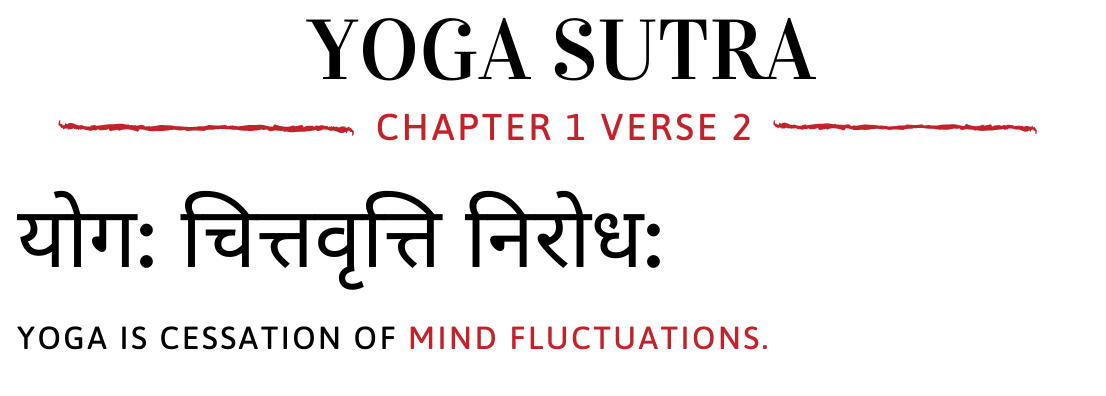
The first chapter, Samadhi Pada, sets the foundation for understanding the true essence of yoga. It defines yoga as the cessation of the fluctuations of the mind (Chitta Vritti Nirodha) and elaborates on different types of Samadhi, or meditative absorption. This chapter is primarily aimed at advanced practitioners who are already disciplined in their spiritual path and seek deeper meditative states.
Key Highlights
- Definition of yoga and its purpose.
- Explanation of Vrittis (mental fluctuations) and how to control them.
- Different types of Samadhi (Savitarka, Nirvitarka, Savichara, Nirvichara).
- Introduction of Ishvarapranidhana (surrender to the divine) as a means to attain spiritual liberation.
Breakdown of Sutras in Samadhi Pada:
- Sutras 1.1 to 1.4 – Define Yoga as the cessation of mental fluctuations (chitta vritti nirodha) and explain the nature of the seer (the self) when the mind is either purified or disturbed.
- Sutras 1.5 to 1.11 – Explain the five types of mental fluctuations (vrittis)—right knowledge, misconception, imagination, deep sleep, and memory—and how yoga helps transcend them.
- Sutras 1.12 to 1.16 – Describe the twofold approach to achieving mental stillness: persistent practice and detachment (abhyasa and vairagya).
- Sutras 1.17 to 1.18 – Define different levels of Samadhi (meditative absorption) and the role of samskaras (impressions of past karma) in influencing one’s spiritual progress.
- Sutras 1.19 to 1.22 – Categorize different types of seekers and emphasize the roles of faith, determination, and memory in advancing on the yogic path.
- Sutras 1.23 to 1.29 – Highlight the significance of Ishvara (the Supreme Being) and OM as its sacred symbol, emphasizing devotion (Ishvarapranidhana) as a means to liberation.
- Sutras 1.30 to 1.32 – Identify nine obstacles that hinder progress in yoga, such as doubt, laziness, and distractions.
- Sutras 1.33 to 1.39 – Provide practical methods to overcome these obstacles, including cultivating positive attitudes and focusing on breath or inner light.
- Sutras 1.40 to 1.51 – Once the mind is stabilized, these sutras guide the seeker through different stages of Samadhi, ultimately leading to Kaivalya (absolute liberation).
2nd Chapter: “Sadhana Pada” explains steps to union
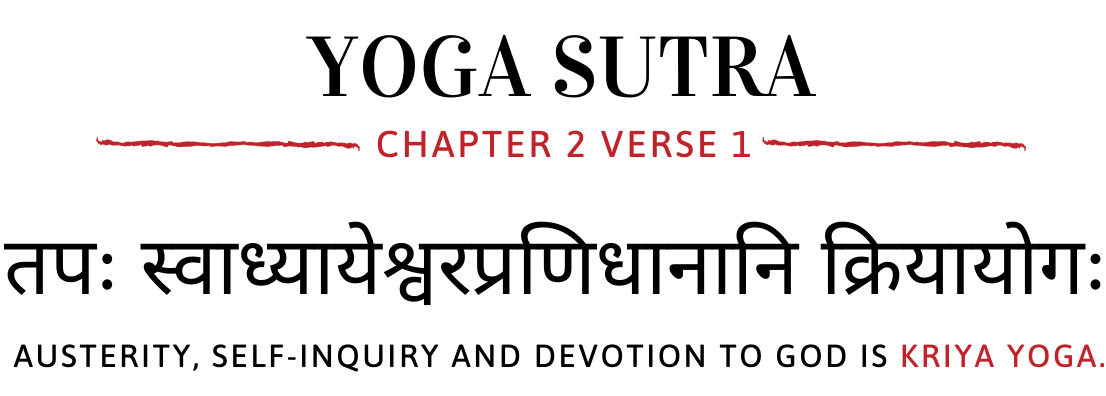
The second chapter, Sadhana Pada, focuses on the disciplined practice required to progress on the yogic path. It is here that Patanjali introduces the Ashtanga Yoga (Eightfold Path), which serves as a step-by-step guide for achieving spiritual evolution.
Key points in Sadhana Pada:
- Introduction of Kriya Yoga (the yoga of action): Tapas (discipline), Svadhyaya (self-study), and Ishvarapranidhana (devotion).
- Explanation of the causes of suffering (Kleshas) and how to overcome them.
- Detailed breakdown of the Eight Limbs of Yoga (Ashtanga Yoga):
Breakdown of Sutras in Sadhana Pada
- Sutras 2.1 to 2.2 – Introduce Kriya Yoga (the yoga of action), comprising:
- Tapas (austerity)
- Svadhyaya (self-study)
- Ishvara Pranidhana (surrender to God)
These practices purify the mind and prepare it for higher meditation.
- Sutras 2.3 to 2.9 – Discuss the five kleshas (afflictions) that cause suffering:
- Avidya (ignorance)
- Asmita (egoism)
- Raga (attachment)
- Dvesha (aversion)
- Abhinivesha (clinging to life)
Understanding and addressing these afflictions is essential for spiritual progress.
- Sutras 2.10 to 2.11 – Explain the effects of these afflictions:
- They are present in both subtle and manifest forms.
- They cause suffering until eliminated.
Meditation is a key method to overcome them.
- Sutras 2.12 to 2.14 – Describe how the impressions of past actions (samskaras) are rooted in the kleshas and influence future experiences. Eliminating these impressions leads to liberation.
- Sutras 2.15 to 2.16 – Elaborate on the nature of the kleshas and their impact on actions and reactions, perpetuating the cycle of suffering.
- Sutras 2.17 to 2.18 – Define the nature of samskaras (mental impressions) and how past actions leave deep traces that affect the mind.
- Sutras 2.19 to 2.21 – Discuss the importance of understanding the nature of mind and the role of meditative practice in transforming these mental impressions.
- Sutras 2.22 to 2.26 – Present how to purify the mind through discipline, detachment, and devotion, and how the mind’s distractions can be removed through focused meditation.
- Sutras 2.27 to 2.29 – Explain the stages of practice and the progress that a yogi experiences as they move through these stages: from Dharana (concentration) to Dhyana (meditation) to Samadhi (absorption).
- Sutras 2.30 to 2.32 – Describe the ethical observances (Yamas and Niyamas) and how they serve as the foundation for personal growth and discipline.
- Sutras 2.33 to 2.35 – Provide techniques for overcoming distractions and obstacles through mental training, focus on breathing, and cultivating a positive attitude.
- Sutras 2.36 to 2.39 – Explain the qualities of a practitioner who has developed mastery in meditation, including fearlessness, self-control, and the ability to resist distractions.
- Sutras 2.40 to 2.45 – Discuss the importance of Pratyahara (withdrawal of the senses) and how it enables deeper concentration and ultimately leads to self-realization.
- Sutras 2.46 to 2.48 – Define Asana (physical postures) and how they contribute to the practice of yoga by creating a steady, comfortable posture for meditation.
- Sutras 2.49 to 2.53 – Discuss Pranayama (control of breath) and its role in regulating the life force (prana), leading to mental clarity and stability.
- Sutras 2.54 to 2.55 – Explain Pratyahara (withdrawal of the senses) and how it enables deeper concentration and ultimately leads to self-realization.
3rd Chapter: “Vibhuti Pada” explains powers of yoga
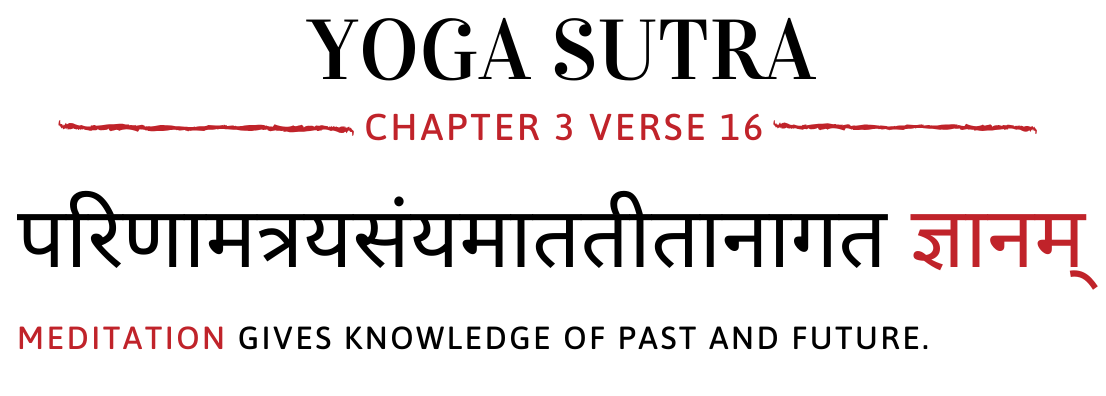
The third chapter, Vibhuti Pada, describes the extraordinary capabilities (Siddhis) that yogis may develop through dedicated practice. These include heightened sensory perception, mind-reading, and even supernatural abilities. However, Patanjali warns that these powers, though fascinating, can become distractions on the spiritual path.
Key points in Vibhuti Pada:
- Explanation of Dharana (concentration), Dhyana (meditation), and Samadhi (absorption) as a combined practice called Samyama.
- Description of various Siddhis (spiritual powers) and how they manifest.
- Caution against being attached to these powers, as they can hinder enlightenment.
This chapter serves as both an inspiration and a warning, guiding yogis to remain focused on liberation rather than getting lost in mystical abilities.
Breakdown of Sutras in Vibhuti Pada
- Sutras 3.1 to 3.3 – Introduce the final three limbs of Ashtanga Yoga
- Dharana (concentration): Fixing the mind on a single point or object.
- Dhyana (meditation): Sustained focus, leading to a flow of awareness.
- Samadhi (absorption): Complete merging with the object of meditation.
These three together are called Samyama, the gateway to unlocking deeper powers.
- Sutras 3.4 to 3.9 – Explain Samyama and its transformative power
- Samyama: The combined practice of Dharana, Dhyana, and Samadhi.
- Application: When applied to different objects or concepts, Samyama reveals hidden knowledge and abilities.
- Example: Practicing Samyama on the sun can reveal knowledge of the solar system.
- Sutras 3.10 to 3.16 – Discuss Parinama (transformation) and its types:
- Nirodha Parinama: Transformation through stillness (calming the mind).
- Samadhi Parinama: Transformation through meditative absorption.
- Ekagrata Parinama: Transformation through one-pointed focus.
These stages mark the yogi’s progress toward mastery.
- Sutras 3.17 to 3.49 – Explore the Siddhis (supernatural powers):
- 3.17 to 3.18: Understanding the relationship between words, objects, and their deeper meanings.
- 3.19 to 3.21: Gaining knowledge of past lives and others’ minds.
- 3.22 to 3.24: Developing invisibility and extraordinary strength.
- 3.25 to 3.29: Mastering elements like earth, water, fire, air, and space.
- 3.30 to 3.34: Achieving perfection of the body and senses (e.g., immunity to hunger and thirst).
- 3.35 to 3.39: Gaining control over natural forces and cosmic knowledge.
- 3.40 to 3.44: Mastering the senses and achieving lightness (e.g., levitation).
- 3.45 to 3.49: Attaining perfection of the body and mind, leading to liberation.
- Sutras 3.50 to 3.56 – Explain Kaivalya (liberation):
- 3.50 to 3.52: The yogi transcends attachment to even the highest powers.
- 3.53 to 3.55: Achieving Viveka Khyati (discriminative knowledge) between the pure Self and the mind.
- 3.56: The final stage of Kaivalya, where the Self exists in its pure, liberated state, free from all afflictions and karma.
Key Takeaways from Vibhuti Pada
- Samyama: The key to unlocking deeper knowledge and powers.
- Siddhis: Extraordinary abilities that arise from advanced practice but are not the ultimate goal.
- Kaivalya: The true purpose of yoga—liberation from all attachments and limitations.
4th Chapter: “Kaivalya Pada” Explains Concept of Liberation
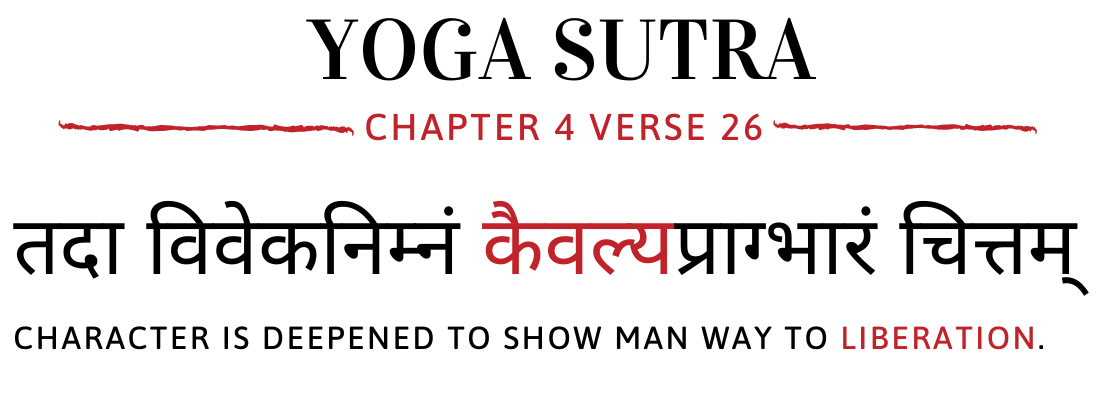
The final chapter, Kaivalya Pada, describes the ultimate goal of yoga—complete liberation (Kaivalya), where the practitioner transcends all worldly attachments and realizes their true nature as pure consciousness. This state is beyond all dualities and leads to eternal peace.
Key points in Kaivalya Pada:
- How the mind dissolves, leading to Kaivalya (liberation).
- The distinction between Purusha (pure consciousness) and Prakriti (nature/matter).
- Overcoming past karmic influences to attain absolute freedom.
This chapter concludes the Yoga Sutras with the assurance that through dedicated practice and inner wisdom, enlightenment is achievable.
Breakdown of sutras in kaivalya pada
- Sutras 4.1 to 4.3 – Attaining Siddhi (Spiritual Powers)
- 4.1: Siddhis (powers) can be gained through:
- Birth (janma), herbs (aushadhi), mantras (mantra), austerity (tapas), or meditation (samadhi).
- 4.2-4.3: Transformation (parinama) is driven by effort and divine grace.
- Key Idea: Spiritual progress requires both discipline and surrender.
- 4.1: Siddhis (powers) can be gained through:
- Sutras 4.4 to 4.6 – The Power of Chitta (Mind-Stuff)
- 4.4: Individual consciousness (asmita, ego) creates distinct realities.
- 4.5-4.6: The mind’s activity projects multiple realities, but a yogi’s mind is unified and focused.
- Example: A calm mind sees truth; a distracted mind creates illusions.
- Sutras 4.7 to 4.8 – Karma and Its Effects
- 4.7: Actions (karma) are neutral but colored by desires (kleshas).
- 4.8: Past actions (samskaras) shape future experiences.
- Takeaway: Liberation requires dissolving karmic imprints.
- Sutras 4.9 to 4.11 – The Role of Desires
- 4.9-4.10: Desires (vasanas) create continuity across lifetimes.
- 4.11: Desires are sustained by memory and attachment.
- Solution: Detachment (vairagya) breaks the cycle.
- Sutras 4.12 to 4.14 – The Tri-Gunas (Three Qualities of Nature)
- 4.12: Reality is governed by three qualities:
- Sattva (purity), Rajas (activity), Tamas (inertia).
- 4.13-4.14: The interplay of Gunas creates all experiences.
- Goal: Transcend the Gunas to achieve liberation.
- 4.12: Reality is governed by three qualities:
- Sutras 4.15 to 4.28 – Removing Obstacles to Liberation
- 4.15-4.17: The mind perceives objects differently based on perspective.
- 4.18-4.21: The true Self (Purusha) is unchanging; only the mind fluctuates.
- 4.22-4.24: Liberation comes when the mind reflects the Self’s purity.
- 4.25-4.28: Practice (abhyasa) and discernment (viveka) dissolve ignorance (avidya).
- Sutras 4.29 to 4.33 – Stages of Liberation
- 4.29-4.30: Renouncing even the desire for enlightenment leads to dharma megha samadhi (cloud of virtue).
- 4.31-4.33: In liberation:
- Sutra 4.34 – The Final State of Kaivalya
- 4.34: Kaivalya is absolute freedom:
- The Self (Purusha) exists in its pure essence, untouched by time, karma, or the mind.
- Metaphor: Like a lamp undisturbed by wind, the liberated Self remains steady.
- 4.34: Kaivalya is absolute freedom:
Key Takeaways from Kaivalya Pada
- Liberation is Beyond Powers: Siddhis are milestones, not the goal.
- Transcend the Gunas: True freedom lies outside nature’s three qualities.
- Dissolve Karma: Detach from desires and past impressions (samskaras).
- The Self is Eternal: Liberation is realizing you are the unchanging witness.
Conclusion
In conclusion, the Yoga Sutras of Patanjali offer a profound guide to achieving self-realization and liberation through mental discipline and spiritual practice. By addressing the nature of the mind, obstacles, and the path of devotion, Patanjali provides a structured framework for personal transformation.
Patanjali’s teachings on concentration, meditation, and higher states of consciousness lead practitioners toward inner peace and ultimate freedom. The Yoga Sutras remain a timeless and invaluable resource for those seeking spiritual growth, offering clear insights into how to transcend worldly distractions and connect with the higher self.
![How to Use A Neti Pot Correctly [Complete Beginner’s Guide Step by Step] How to Use A Neti Pot Correctly [Complete Beginner’s Guide Step by Step]](https://www.fitsri.com/wp-content/uploads/2020/02/neti-pot-211x150.jpg)




Thank you for your elucidation. I am curious where in the Purana is written the story of Patanjali’s birth/incarnation?
The story of Patanjali’s birth/incarnation is not explicitly detailed in the Puranas. Patanjali is primarily known for his compilation of the Yoga Sutras, and there isn’t a widely recognized mythological narrative about his birth in traditional Hindu scriptures. The focus of Patanjali’s association is more on his contributions to the field of yoga philosophy rather than his personal background as described in Puranic texts.
plz make a detailed explanation on koshas, on the basis of the quantum level and cosmologic characteristics.
eg-11prana in 3 body and its characteristics, similarly the 4th and 5th kosha-with quantum particles and properties and info!
I hope u will do proper deep research for us and add it up to this site.
thank u, sir.
Excellent Comprehensive & Explained Simply.. That’s really commendable for difficult Subject of YSP.
CONGRATS & BEST WISHES.
Hari ॐ ?
Feeling blessed reading articles on Yog Darshan
Ashish,
Nice work on the Yoga Sutras, but some important clarifications:
God is not part of the Hindu/Yoga Dharma.
Unlike so many, you do recognize the Hindu/Yoga connection. It only stands to reason then, that those who teach any aspect of Yoga are qualified Hindus.
Patanjali was only teaching Male, Hindu renunciants. Clarify what is Brahmacarya.
Patanjali did not teach any specific asana and therefore you should equate asanas with Patanjali.
You recognize that true learning of the Hindu/Yoga Dharma is extensive and takes a long time, and therefore, the whole notion of today’s “teacher training” is a total contradiction.
Bottom line: Real Yoga is all about Hindu Dharma (Hinduism/Hindu religion), taught by Hindus and not for a fee.
Swami Paramatma
Swami Paramatma, thank you for your precious comment.
Despite the fact, everybody could have their own point of view for an aspect, I respect all the points you mentioned above. However, I would like to comment on these two points.
1- Though Patanjali didn’t mention any particular asana in YSP, he summarizes the real nature of any asana in one sutra (2.46).
2- To begin in the yogic journey, everybody needs to have an initiation & in today’s age, “teacher training” could be a part of this initiation.
I am glad to know your thoughts over YSP. Thanks for sharing it with us.